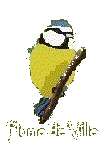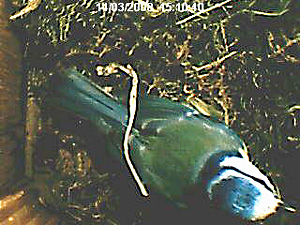Plume de Ville
From day to day.
°°°°°°°°°°°°°°°°°°°°°°° °
13 March
The
sky is
always overcast, but the weather just settled down. 13°C.
As
usual, Madame returned to bed every night.
This time, it's started; she is full engaged in the construction activity of the nest since two days.
Ceaseless comings
and goings to bring moss, a large portion, in fact, too large portion.
She has
some difficulties to judge the diameter of the entry and the tuft
decidedly
does not enter.
She forces,
retries from another angle, clings better and success entering, losing
half of
her load!
She
found a
good source of moss, not very far, in the inner garden in our building.
We can
follow her, harvesting the moss and taking off to our balcony.
He
is not involved in the construction of the nest. He often accompanies
her,
stands guard next to the nest box. He quickly drives away the great tit
which comes
to our balcony to sing lengthily and aloud. The latter uses all the
possible
variations of his song, and sometimes I do not even recognize her. As
she comes
often here to sing, I think its nest should be nearer than last year.
 She
will
pack this moss by pushing it against the walls with her body. One can see here the movements
that I called "fan" which find their
explanation here. Okay, at first glance, the result seems rather a
chance result,
but it works. Slowly the moss will settle and the centre will become
hollow to
form the nest cup.
She
will
pack this moss by pushing it against the walls with her body. One can see here the movements
that I called "fan" which find their
explanation here. Okay, at first glance, the result seems rather a
chance result,
but it works. Slowly the moss will settle and the centre will become
hollow to
form the nest cup.
This video
was taken with the colour camera, I took advantage of the sun to add a
little
light that did not disturbed her I still leave the photos with the IR
camera, and
I will switch, from time to time, to colour in the hours of the day
when the
nest box is already naturally well-lit.
14 March
Under
an
overcast sky the construction of the nest continued actively.
Moss
is packed against the walls of the nest box and the center is clear.
15 March
Mild
weather. 17 °C in the afternoon.
The
first
ladybug wakes up and leaves its shelter where she spent the winter (in
diapause).
A tasty viola pot, where I spotted beautiful plump aphids, awaits her.
I hope
it will have girlfriends. (The balcony has no insecticide treatment.)
Probable Asian lady beetle (harmonia axyridis).
16 March
Day of rain and strands of straw.
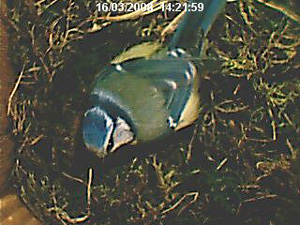
17 March
Beautiful
sun early this morning. 6 °C
The
prunus
is in bloom and interest very much the tits that remove the petals one
by one,
to reach the heart of the flower. Pink snow.
The
acrobats hang on small twigs of the tree.
Acrobats
also when it comes to enter with a nice tuft of moss through this tiny
entrance.
Come back
to our couple of wood pigeons, cooing gently in their window box. We
belong to
their territory.
There are a lot this year. Between 11am and noon every day a flock of
about
thirty pigeons fly southward, leaving Paris.
18-19 March
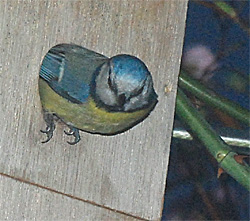
There
is
cold, wind and showers. Not eager to leave. She leaves the nest box
earlier and
earlier in the morning.
The
big
construction activity has slowed. She continues to bring twigs.
Frequent nest
felting.
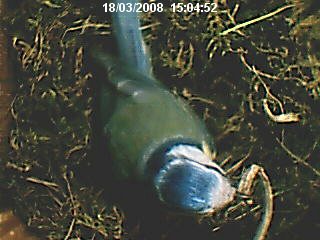
20 March
Cold
sun
this morning (5 °C).
With the light, at 6:30, she was already out. Same packing activities.
The moss
and twigs begin to be high. She keeps the centre clear.
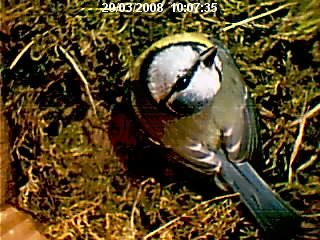
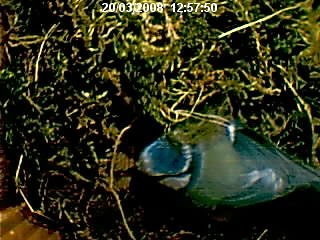
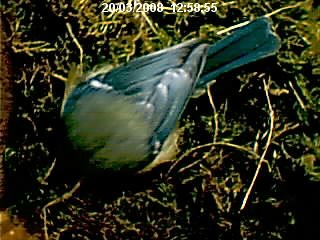
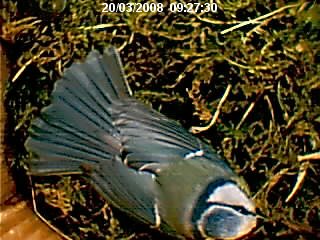
21 March
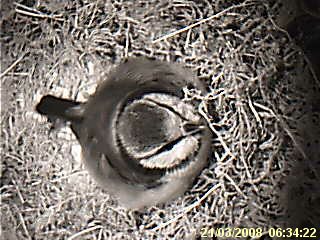
Wind and
rain under a grey sky do not incite to wake up. As usual after a short
tour at
the door, she gets back to bed and she will leave only a quarter of an
hour
later.
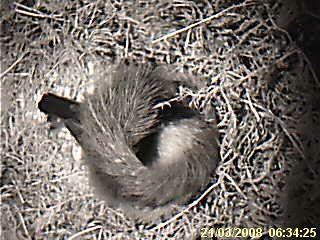
A ray of sun and our friend the greenfinch comes to pose for a moment.
22 March
Tormented day. wind, hail, cold.
At 6:40,
the sun rises, Madame too.
The tender
clematis did not withstand the winds. Its shoots are broken.
23 March
It freezes
in this morning of Easter Sunday. The wind subsided.
24 March
Always the
wind. 5 °C
Alternating sunshine and grey. Small rain.
Oddly
enough, this year she doesn't try to enlarge the entrance of the nest
box. She
continues to mat the nest moss regularly, but believes that for the
moment, the
work is sufficiently advanced, and she doesn't bring anymore materials
to the
nest box.
Are you there?
He sometimes dares enter the nest box after much hesitation. If she is
near, she
enters immediately behind him, who exits as a jack-in-the-box.
Monsieur great tit comes to sing his head off.
He would
not be outdone. The high branches of the prunus and the birch advance
outside
the building, they are a good observation post and singing there bears
very far.
It is 7:30am.
A big 'poc' against the glass. A sparrow hit the window and I see it
fly away
vertically. Curious. This happened once or twice with young or when
fights
break out. One day, a sparrow, the window being open, entered,
traversed the apartment
and emerged on the other side by another window. It must still wonder
how he
ended up on the other side!
But this morning, almost simultaneously, a shadow, a magnificent
kestrel falcon,
rushed to the balcony pursuing four sparrows which took refuge on the
ground
between the potted plants. This time I saw it very well. It is
certainly a kestrel
falcon. He tries to continue the hunt on the ground, but they are well
hidden
and it is constrained to pass through the leaves of the hydrangea. I
approached
and probably, seeing me, he hesitates, perches on the edge of the
balcony and
waives.
More doubt about previous visits. This is the third time in recent
months.
26 mars
Grey sky, 12°C.
 In the
morning, like a lot of people, she has some difficulties to decide to rise even
though he comes for her and call for awakening. He looks into the nest box,
sings and sings again but she needs a good moment before deciding. She put the
head at the door, looks lengthily and then goes back to sleep. This doing can
happen four or five times.
In the
morning, like a lot of people, she has some difficulties to decide to rise even
though he comes for her and call for awakening. He looks into the nest box,
sings and sings again but she needs a good moment before deciding. She put the
head at the door, looks lengthily and then goes back to sleep. This doing can
happen four or five times.
Watch VIDEO (852ko 22s)
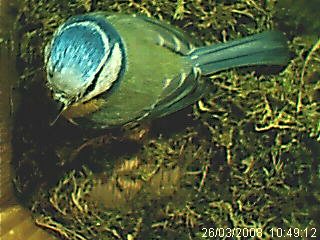
Today, big
business to complement the nest, she made me lie.
She spent the morning bringing moss and twigs and spent very long time in the
nest box.
Maybe it is
necessary to leave the first layer of moss settle and dry?
The morning is active but in the afternoon they are present and have their
habits. Generally, we do not see them from 16h until she returns to bed, currently
around 19h.
28 March
Dawn full
of promises this morning. Leave early (6:30 am) and the rest of the day under a
grey sky (10 °C).
A nice little parade this morning. Around 6:30, the mixed colours of a jay
attract the eye on the poplar, happy to see him again. He did not stay long.
Later in the morning, "our" blackbird arrives, we see him pass often
move by now. He sings lengthily in the garden early in the morning, while it is
still dark. A brood like last year? Probable.
Finally, the greenfinch in turn makes us a visit while dunnock sings in the
garden.
Why! No great tits. Their breeding are generally in advance compared to the
blue tits ones.
The blue
tits? They are here and well here, they do not leave the nest box and the
balcony during all the morning. He sings and sings, his little phrase repeated
indefinitely. He does not tire! Perhaps we... No, it's not true; we like to
hear him singing.
She enters and leaves the nest box, no construction today. She decided to
inspect the camellia in search of insects ... and snare the photographer. The
sparrows also look for insects and spend time to scrutinize the plants of viola
that are attacked by aphids. Thanks to them, continue my friends.
Say aaaa!
(Watch a
larger photograph.
Pictures with a larger version will henceforth be framed)
Here they
are both of them. Guess who's who.
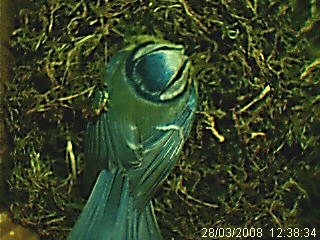 It is 17:30;
it's raining gently. They left since 14h. She spent the nights in the nest box
for a month (February 27). Last year at the same date of 28 March, the female
remained to sleep in the nest box for the first time and, on April 6 and laid
the first egg.
It is 17:30;
it's raining gently. They left since 14h. She spent the nights in the nest box
for a month (February 27). Last year at the same date of 28 March, the female
remained to sleep in the nest box for the first time and, on April 6 and laid
the first egg.
A sparrow is on the nest box and she does not like it at all and protests.
Arranging the centre of the nest, upside down. Later we will see her often in
this position, plunging deeper.
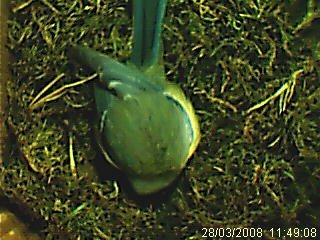
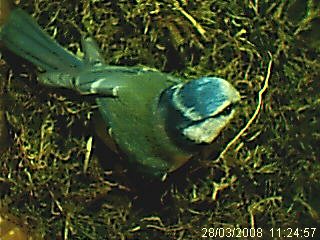
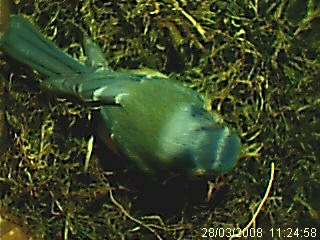
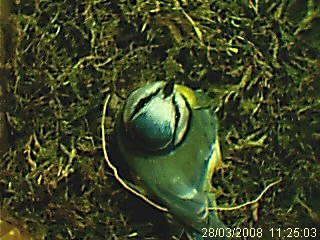
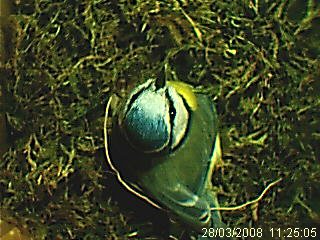
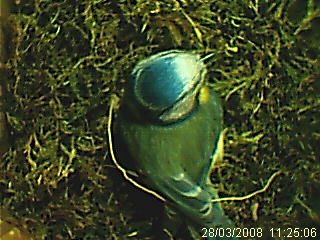
Around 18h he finally arrives. He began to call, changing feverishly his position on the balcony. His belle is not here! It will call her non-stop for 20 minutes until she finally arrives. They will leave together. La belle will come back at about 19h and will spend ten minutes
enjoying
the last rays of sunshine, accommodating its feathers before going to bed.
29 March
The weather
is fine, warm day, the spring arrived.
Rise early this morning, 6:20.
You go out?
30 March
Rain, rain and still more rain.
31 March
Yesterday the sleeping beauty leaved at 6:30. With the change to the daylight saving time, we thought that shi will awake an hour latter at about 7:20, 7:30. Well no!
It was 6:50 and she has already leaved! Does the tit is aware of the clock change, and she decided to apply the summer schedule? Or she decides to exit not only in terms of light but also in terms of the city noise?
We will see tomorrow.
Also they
work hard to build.
Our friend she-sparrow benefits of cotton, available to builders.
Dame blue
tit has not been tempted. She stacks always moss, but the nest does not contain
yet softness like feathers, horsehair.
This is the
copy of a call to report the firsts seeing of the Asian ladybug (Harmonia
axyridis) in France this spring.
Le
15 March je vous présentais la petite coccinelle sortie du
coin de ma
fenêtre (précocement). Ses copines ne vont pas
tarder à sortir. Alors
avis de recherche de l'observatoire permanent de la
coccinelle asiatique:
"La petite
vague de mauvais temps étant finie,
l'amélioration des conditions
météorologiques devrait favoriser
l'activité des Coccinelles asiatiques. Fini le repos
hivernal, place à la reproduction ! Dans les prochains
jours, vous devriez observer des coccinelles actives autour des
fenêtres qui essaient de rejoindre la verdure.
N'hésitez pas à nous transmettre vos
observations, elles nous permettent de tenir à jour la carte
d'évolution nationale :
http://pagesperso-orange.fr/vinc.ternois/cote_nature/Harmonia_axyridis/observatoire_carte_evolution.htm
Nous sommes preneur de toutes les infos, même dans les
départements où elle est supposée
abondante... Comme vous pouvez le voir, elle occupe
désormais une grande partie de notre territoire. Nul doute
que les observations se multiplieront cette année en
Bourgogne, Franche-Comté, Rhône-Alpes, Auvergne,
Bretagne, Limousin... merci de nous en informer. Certains d'entre vous
ont observé l'espèce à l'automne
dernier, il est toujours temps de nous transmettre les infos.
En cas de doute sur la détermination,
vous pouvez nous envoyez (aux correspondants régionaux
désignés) des clichés pour
validation... même s'il s'agit d'espèces
indigènes, c'est avec plaisir que nous vous aiderons
à leur donner un nom.
Comme vous pouvez le voir sur le site internet, l'Observatoire
contribue au suivi de cette espèce en Europe. Ce
phénomène est aujourd'hui loin de concerner la
Belgique, les Pays-Bas, la Grande-Bretagne et la France, il
s'agit d'une problématique européenne, voir la
synthèse cartographique : http://www.europe-aliens.org/pdf//Harmonia_axyridis.pdf
Vinc. TERNOIS Observatoire permanent pour le suivi de la Coccinelle
asiatique "
